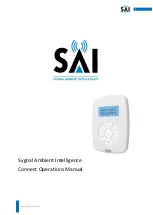
HFC Enhance
®
– QFHPN High Power Optical Node with AGC – Installation & Operation Manual
3-1
CHAPTER 3: POWER UP AND TEST
POWER UP AND TEST
3. Power Up and Test
The compact node is now ready for power up.
3.1 Connect the Power Adapter
Insert the 5mm power plug from the power converter into the power port of the compact node and plug the adapter into the
120VAC wall outlet.
The compact node will conduct a self-test and the power LED will be flashing. As the test proceeds each of the mode LEDs
are lit in sequence. When the self test is complete, the output power LED is lit, and the display shows the current RF output
power level.
A green power LED indicates that the unit is operating correctly and the RF output is within acceptable limits. (See alarm
indicator section if the SYS/ALARM LED is not showing green).
Secure the low voltage cable from the compact node such that it does not become easily tangled or dislodged.
3.2 Verify Signal Levels
The compact node is equipped with a built in power meter for the RF output and the optical input/outputs. Use the arrow control
keys to select the values you want to view as follows:
3.2.1 Check RF Power Output Level
Use the arrow control buttons to select the RF LEV mode. (When the compact node completes its initial diagnostics, it will
automatically be selected). The display indicates the RF output power, measured in dBmV/Ch. Note that the attenuation
setting will directly affect the output power value for the compact node.
•
Using an RF Signal Meter, confirm the RF downstream power level output. The output level should be approximately
+40dBmV per channel with an optical input of from -8 to +1dBmV.
◦
The RF level can also be measured from the RF output test port. The level at the test port will be
approximately 20 dB below the actual RF output level.
3.2.2 Check Optical Power Receive and Optical Output Levels
Use the arrow control buttons to select the OP IN/OUT mode. Both the input and the output optical power levels can be viewed.
Enter the OP IN/OUT mode by pressing the down arrow and the display shows the optical input power from the network. The
value on the display is shown in dBm, and should be between -9 and +1. (The ideal setting is -3)
Pressing the down-arrow button again shows the upstream optical output power level being generated by the compact node,
also measured in dBm. This value should measure between 0 to +2.
•
Using an Optical Power Meter, verify that the downstream (forward path) signal on the fiber cable coming from the
head-end is between -9 and + 1 dBm.
•
Using an Optical Power Meter, verify the upstream output of the compact node (return path) is between 0 and +2dBm
(QFHPN-2W only).
3.2.3 Check the Upstream RF Power Level (QFHPN-2W only)
The compact node has no direct measurement of the upstream RF power it is receiving. You will need to confirm the received
RF power from a cable modem at the head-end, or at the RF test port on the CATV compact node.
•
Using an RF Signal Meter, verify the RF input to the compact node is 23 dBmV and +35dBmV. The
measurement at RF upstream input test port will be 20 dB below the actual input level.
































